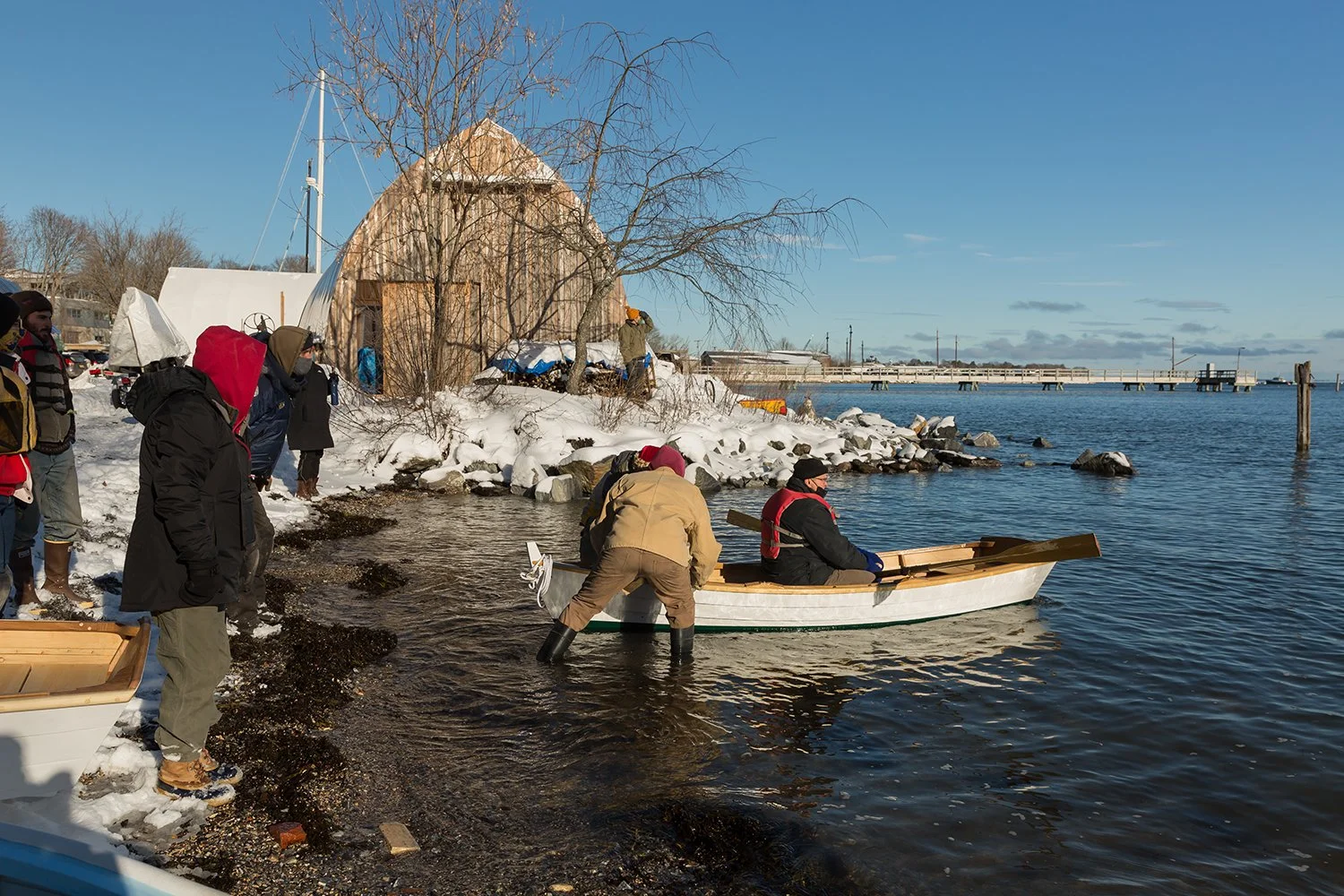Towards an Anthropology of Wooden Boatbuilding
by Yonatan Goodman (alumnus ‘20-’21)
From launch day on December 18th, 2020. Photo Credit: Erin Tokarz
People talk of wooden boats as romantic, graceful objects, wherein form is married to function, beauty to pragma. This may be, but in the day-to-day life of a boatbuilder, a different fetishism emerges and a controversial view of hackneyed mythologies.
Take fairing, for example. Spend a couple of months on your knees, your arms working above your head, hacking daily at oak end grain with rusty planes and 4' grinders. The wood dust graying your hair falls into your face every time you take off your breathing and eye protection. When you've finished removing material, you'll invariably find that you've taken too much off. You'll proceed to shim and glue, only to have to fair material down again, seemingly ad infinitum. Opening your mouth to speak and coordinate the effort, the heating system will awaken with a deafening roar. A thickness planer will encounter a majestic quarter-sawn slab of something-or-other, making speaking impossible. As the days begin to blend into one another, you might start to think you have come upon an unusual and (literally) antediluvian form of punishment, appropriate for those damned to Tartarus.
Yet somehow, against the odds, your heart might just then be filled with a yet unknown gladness; your body at day's end will feel like a vessel of quiet satisfaction. Walking along the dock in the evenings, you find in the waters wordless reflections and a deep love for the unnamed boat, if not for its grace then for the consuming integrity of the work.
The work's rhythm is pregnant with meditative and therapeutic possibilities and can be downright spiritual. Yet in the boat shop's everyday practices, the metaphysical issues presented by The Ship of Theseus dissolve in soupy data. Epoxy types and ratios, oil vs. water stones, Shellac vs. SealCoat, the extent of perennial upkeep and maintenance required by wooden vessels, and the inevitable replacement of planks and oak ribs, steamed or boiled. By the time you have launched your Susan Skiff, you will find you have become a fervent detractor of Platonism. Your euphoric desire for Ideal Forms will have been shattered by material realities and your struggle to ascertain wood grain direction. Softwood will chip and smash under you, paint will drip. The idiosyncratic mistakes of apprentice builders make each boat 'singular,' if of a recognizable type. Luckily, polite society refers to this type of neglect and shorthandedness in your boat as 'character.'
Nevertheless, even ankle deep in wood dust and construction details, you can never escape the poetics of your project. For all their sensuous, unimpeachable physicality, the charm and enigma of wooden boats exist in the language describing them and the stories surrounding them. Boatbuilders have the sculptural acuity to perceive fair lines, and they have drawers full of sharp planes and chisels. But they also possess imaginations capable of fantasizing about the magic, the possibilities, and the adventure pregnant in their creations. Even in antiquity, perhaps more so then.
And these imaginations are shared. It is there, in the collective unconscious of boats, that I find our own boat shop, The Apprenticeshop. For if boatbuilding is a shared narrative, a mythos, The Apprenticeshop is the congregation that gathers to tell it. Community building and meaning-making are the cultural underpinnings of Lance Lee's project and everyday life at the ‘Shop. Talking shop constitutes the space. Of course, talking itself does not build boats and Walk Around (during which apprentices and staff go around the building surveying the week's progress) as a community forum has and ought to be constantly problematized. Yet, the boats are usually built in pairs and small groups, turning the boatbuilding itself into a shared dream and a feat of delicate coordination. Narratives of shared stewardship are embedded in weekly clean-up, community lunch, and expeditions in Penobscot Bay. All these make one feel like an Apprentice, a participant in Tradition, connected to everyone else who has passed through the school at its various locations.
To be a part of this community is not always easy. Yet, it is the most rewarding part of the experience. You carve friendships in that space by making something together, by playing together once more, as in childhood. Folks work together not simply for efficiency or mutual benefit but in the more profound paradigm of barn raising and community work so central to Lance Lee's vision. This American Romanticism of social rituals and direct democracy may be an anachronism. Still, there's a clue about civic engagement hiding in the legend of apprentices cohabiting in yurts and the possibilities and challenges of weekly apprentice meetings.
In this realm of American communitas, The Apprenticeshop is an inspiration, and it stands out as an emblem of the Maine Spirit. It emerges out of a crucible of natural forces, attracting people from around the world and at different stages of life. The sharpness of the North Atlantic sea, the granite shaped by glaciers, the white pine, the cedar, the oak, the lobster women, lobster pots, and the potters. It is a revival of American craft that has endured for half a century, seeking authenticity in an age of simulacra.

